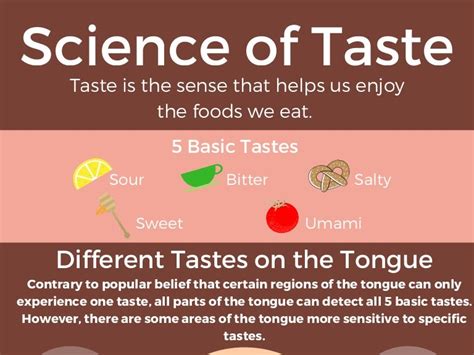Are you curious about the fascinating world of taste and how it intertwines with the field of food technology? From understanding taste perception and sensory science to exploring the impact of food processing on flavor, the science of taste is an intricate and dynamic field that continues to evolve. In this blog post, we will delve into the relationship between flavor and food technology, examining innovations that have enhanced our flavor experiences. We will also discuss the role of chemistry in creating taste sensations and how technology is being used to analyze and replicate natural flavors. Additionally, we will explore advancements in food technology for texture and mouthfeel, as well as the harnessing of biotechnology for sustainable and nutritious foods. Join us as we uncover the influence of food technology on consumer preferences and discuss emerging trends and future possibilities in this exciting field. Whether you’re a food enthusiast or simply intrigued by the intersection of science and taste, this post will provide insight into the intriguing world of food technology.
Table of Contents
Understanding taste perception and sensory science
When it comes to taste perception and sensory science, there is much more at play than just enjoying a delicious meal. Our ability to taste and experience flavors is a complex process that involves not only our taste buds but also our sense of smell, touch, and even the sound of food. It’s a fascinating area of study that explores how we interpret and interact with the world through the food we eat and the drinks we consume.
One of the most interesting aspects of taste perception is that it can vary greatly from person to person. What one individual perceives as bitter, another might find appealing. This diversity in taste preferences has led researchers to delve into the science behind how our taste buds and sensory receptors work, and how our personal experiences and memories shape our perception of flavors.
Understanding the science of taste perception can also have practical applications, particularly in the food industry. By gaining insights into how we experience flavors, food technologists and chefs can develop new products and recipes that cater to a wide range of tastes and preferences. This can lead to the creation of foods that are not only delicious but also satisfying and memorable.
Overall, delving into the world of taste perception and sensory science opens up a world of possibilities. From understanding the intricacies of our taste buds to utilizing this knowledge to create innovative and enjoyable culinary experiences, it’s a realm that continues to bring excitement and new discoveries.
The relationship between flavor and food technology
Flavor and food technology have a complex and intertwined relationship that shapes the food industry and consumer experiences. The flavor of a food product is a crucial factor that influences consumer preferences, and food technology plays a significant role in creating, enhancing, and preserving flavor.
Advancements in food technology have enabled the development of various techniques and processes that affect the flavor of food products. From the creation of artificial flavors to the extraction and concentration of natural flavors, food technology has expanded the possibilities for flavor manipulation and enhancement.
Furthermore, food technology has also contributed to the improvement of flavor delivery systems, such as encapsulation and controlled release mechanisms, which help to preserve and deliver flavors effectively in a wide range of food products.
Ultimately, the relationship between flavor and food technology is essential for meeting the evolving demands and expectations of consumers, as well as for driving innovation in the food industry.
Exploring the impact of food processing on taste
Food processing plays a crucial role in shaping the taste and quality of the food we consume. The way in which food is processed can have a significant impact on its flavor, texture, and overall sensory experience. Whether it’s through freezing, canning, drying, or cooking, each method of food processing can alter the taste of the final product.
One of the key influences on taste during food processing is the application of heat. Heat can cause chemical reactions within food that can either enhance or diminish its natural flavors. For example, the Maillard reaction, which occurs when proteins and sugars are heated together, can create rich, complex flavors in foods like bread, coffee, and chocolate.
Additionally, food processing techniques such as fermentation can also have a major impact on taste. The conversion of sugars into alcohol and acids during fermentation not only preserves food but also contributes to its unique flavor profile. Foods like cheese, yogurt, and pickles are all examples of how fermentation can transform the taste of a product.
Overall, understanding the impact of food processing on taste is essential for food technologists and manufacturers. By being aware of the ways in which processing methods can influence flavor, they can create products that meet consumer preferences and deliver an enjoyable eating experience.
Innovations in food technology for enhanced flavor experiences
Food technology has come a long way in recent years, and one of the most exciting aspects of this progress is the innovations in enhancing flavor experiences. Whether it’s through new processing techniques, advanced understanding of taste perception, or the development of natural flavor replicating technology, the world of food technology is constantly striving to deliver more delicious and satisfying products to consumers.
One area of innovation that has had a significant impact on flavor experiences is the use of chemistry to analyze and reproduce natural flavors. By breaking down the chemical components of natural flavors and experimenting with different combinations, scientists and food technologists have been able to create synthetic flavors that closely mimic the real thing. This has not only expanded the range of flavors available to consumers but has also allowed for the creation of more consistent and reliable flavor profiles.
Another area of innovation in food technology is the use of advanced sensory science to understand taste perception. By delving deep into how our taste buds and sensory receptors interact with different flavor compounds, researchers have been able to uncover new ways to enhance the overall flavor experience of food products. This has led to the development of techniques that can boost the perceived intensity of certain flavors or create layers of taste that evolve as a product is consumed.
Furthermore, the impact of food processing on taste cannot be understated. Innovations in food processing technology have allowed for the preservation of natural flavors, as well as the creation of new and unique flavor profiles. Techniques such as high-pressure processing, cold pasteurization, and enzyme-assisted extraction have all contributed to the enhancement of flavor experiences, ensuring that consumers can enjoy food products that are not only safe and convenient but also bursting with deliciousness.
The role of chemistry in creating taste sensations
Chemistry plays a crucial role in creating taste sensations that we experience when consuming food and beverages. The complex interactions between various chemicals in the ingredients and the human taste receptors result in the perception of different flavors.
For example, the Maillard reaction, which is a chemical reaction between amino acids and reducing sugars, is responsible for the browning and development of complex flavors in foods when they are cooked. This reaction contributes to the rich and savory taste of grilled meat, roasted coffee, and toasted bread.
Another significant aspect of the role of chemistry in taste sensations is the interaction between acids and bases. The pH level of a food or beverage influences its taste perception. For instance, acidic foods like lemons and vinegar taste sour, while basic substances such as baking soda have a bitter taste.
In addition to this, the process of fermentation, which involves the breakdown of carbohydrates by microorganisms, results in the production of alcohol and organic acids that contribute to the unique tastes of foods like cheese, wine, and yogurt. The chemical changes that occur during fermentation significantly impact the overall flavor profile of these products.
Using technology to analyze and replicate natural flavors
Advancements in technology have revolutionized the way we approach the analysis and replication of natural flavors. With the help of sophisticated instruments such as gas chromatography and mass spectrometry, scientists are able to identify and analyze the complex compounds that contribute to the unique taste of natural flavors. This level of precision was previously unattainable, and it has enabled food technologists to gain a deeper understanding of the intricacies of flavor.
Furthermore, the development of artificial intelligence and machine learning algorithms has allowed researchers to create models that can predict the flavor profile of a natural ingredient based on its chemical composition. This has streamlined the process of replicating natural flavors, allowing for more accurate and efficient production of flavor enhancers and extracts.
In addition to analytical techniques, technological innovations have also led to the emergence of nanotechnology in the field of food science. Nanoparticles are being used to encapsulate flavor compounds, protecting them from degradation and ensuring a longer shelf life. This has opened up new possibilities for incorporating natural flavors into a wide range of food products without compromising on taste or quality.
Overall, the integration of technology into the study of natural flavors has paved the way for more precise analysis, replication, and utilization of these complex compounds. As technology continues to advance, we can expect further breakthroughs in the field of flavor science, enhancing the sensory experiences of consumers around the world.
Advancements in food technology for texture and mouthfeel
Advancements in food technology have revolutionized the way we perceive texture and mouthfeel in our food. With the use of innovative processes and ingredients, food scientists and technologists have been able to enhance the sensory experience of various food products.
New techniques such as microencapsulation and 3D printing have allowed for the creation of foods with unique textures and mouthfeels that were previously impossible to achieve. These advancements have not only expanded the possibilities for food manufacturers, but have also provided consumers with a wider range of sensory experiences to enjoy.
By leveraging biotechnology and nanotechnology, food technologists have been able to create healthy alternative options that mimic the texture and mouthfeel of traditional foods. This has been particularly beneficial for individuals with dietary restrictions or those looking to make healthier choices without sacrificing the enjoyment of their meals.
Overall, the advancements in food technology for texture and mouthfeel have opened up a world of possibilities for creating new and exciting food products that cater to a diverse range of consumer preferences. As technology continues to evolve, we can expect even more groundbreaking developments in the realm of food texture and mouthfeel.
Harnessing biotechnology for sustainable and nutritious foods
Biotechnology has revolutionized the way we produce and consume food, offering innovative solutions for sustainable and nutritious options. Through the use of biotechnology, scientists and researchers are able to enhance the nutritional content of foods, while also reducing the environmental impact of food production. By leveraging biotechnological processes, we are able to create foods that are not only healthier, but also more resilient and environmentally friendly.
One of the key benefits of harnessing biotechnology in food production is the ability to create sustainable solutions that can address the challenges of an ever-growing global population. Biotechnological advancements allow for the development of crops that are more resistant to pests and diseases, reducing the need for harmful pesticides and herbicides. This not only benefits the environment, but also promotes a more sustainable and efficient food production system.
Furthermore, biotechnology plays a crucial role in improving the nutritional content of foods. Through processes such as genetic modification and biofortification, scientists are able to enhance the levels of essential nutrients in crops, making them more beneficial for human consumption. This has the potential to address widespread issues such as malnutrition and nutrient deficiencies, particularly in developing countries where access to diverse and nutritious foods is limited.
In addition to addressing sustainability and nutritional concerns, biotechnology also has the potential to create foods that are not only healthy, but also delicious. By utilizing biotechnological approaches, we can enhance the flavor and sensory attributes of foods, creating innovative products that are both enjoyable and nutritious. Through advancements in biotechnology, we have the opportunity to redefine the way we produce and consume food, paving the way for a future of sustainable and nutritious options that benefit both the planet and its inhabitants.
The influence of food technology on consumer preferences
Food technology plays a crucial role in shaping consumer preferences. With the advancements in the field of food technology, consumers today have access to a wide range of food products that are tailored to their specific preferences and needs.
One of the key ways in which food technology influences consumer preferences is through the development of innovative and convenient food products. The use of technologies such as advanced packaging, processing techniques, and preservation methods has enabled the creation of ready-to-eat meals, on-the-go snacks, and pre-cooked ingredients, catering to the busy lifestyles of modern consumers.
Moreover, food technology has paved the way for the production of healthier and more nutritious food options, addressing the growing demand for functional foods and dietary supplements. Consumers are now more conscious of their health and wellness, and food technology has played a significant role in offering products that meet these evolving dietary needs.
Additionally, the use of food technology in flavor and texture enhancement has led to the creation of products that are not only palatable but also visually appealing. Food manufacturers have been able to develop new flavors, textures, and sensory experiences through the use of techniques such as encapsulation, fermentation, and controlled release, which have had a profound impact on consumer preferences.
Emerging trends and future possibilities in food technology
As technology continues to advance, the future of food technology holds exciting possibilities for the industry. From the use of artificial intelligence in food production to the development of novel ingredients through biotechnology, the emerging trends in food technology are set to revolutionize the way we produce, consume, and experience food.
One of the most significant emerging trends in food technology is the utilization of big data and artificial intelligence to optimize food production processes. By analyzing large volumes of data, food producers can streamline operations, minimize waste, and maximize efficiency. This approach not only benefits the bottom line but also has the potential to enhance the sustainability of the food industry by reducing its environmental footprint.
Another exciting possibility in the future of food technology is the development of novel ingredients through biotechnology. Scientists are exploring the potential of using genetically modified organisms to produce ingredients that offer improved nutrition, taste, and functionality. This could lead to the creation of healthier, more sustainable food products that meet the evolving demands of consumers.
Furthermore, the integration of 3D printing technology into food production processes is another emerging trend that holds tremendous potential. As 3D printing becomes more sophisticated, it could revolutionize the way we think about food packaging, customization, and even the creation of entirely new food products. This technology has the capacity to disrupt traditional food production methods and open up entirely new possibilities for culinary innovation.






